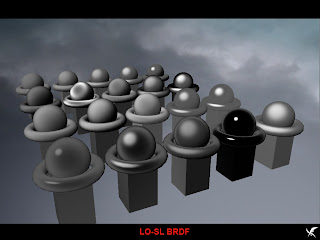LO-SL BRDF Additional Test Materials
As part of my test materials on my previous post about LO-SL BRDF, here are some more materials. The furthest 2 rows are from the older test(refer to previous post). The 2nd to the closest rows, starting from left is matte finish, leather, rough wood, polished varnished wood and plastic. The closest row, opal, jade, ruby, clear glass and my default Phong-Blinn with a nice-and-easy specularity. My favorite material is the clear glass (2nd from the right, closest row), obviously I'm not doing any transparency yet. It seems to really simulate how light reacts to clear glass materials. You would notice that it seems that I'm only rendering a specular fresnel but if you look closely, after the fresnel shade there's a very thin line running a long the outline. It adds some realism or complexity on the rendering, which a normal fresnel rendering would never accomplish.
Currently, I'm using a 256x128 texture look-up tables. I noticed that N.V and Phi I+R can be reduced half of precision and would not make obvious banding. N.V makes sense to be reduced because we can only see the front hemisphere of the Normal according to the view.
Each of the material has a look-up table texture which is a 2 channels 256x128. All of these are then stored in a texture array and is used in the light accumulation pass in a light prepass rendering pipeline. The pipeline is running on view space data, considering how much we save on computing with this space. Each affecting light will react with similar light response and thus adds awesome almost-free complexities to the rendering. I'm really amazed how simple yet how much this technique contributes to the overall rendering. With a simple 2 texture sample taps, it does wonders! A W E S O M E!



Comments